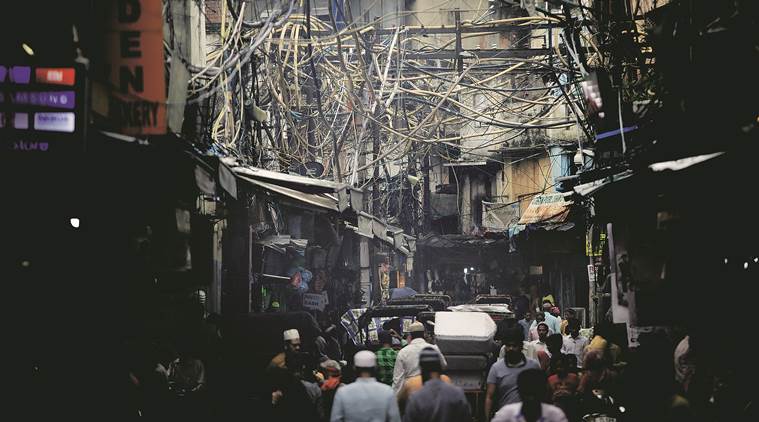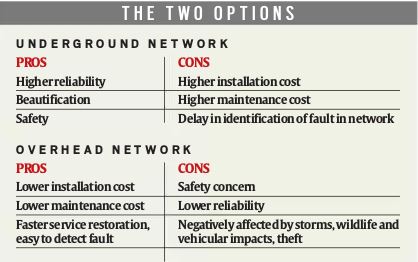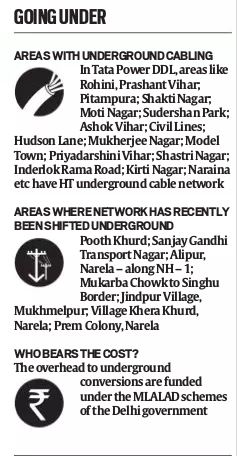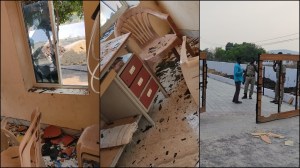- India
- International
Hardlook: Down to the wire
Three electrocution deaths in the city have put the spotlight on the dangers of overhead wires, especially in Old Delhi and unauthorised colonies. Abhinav Rajput & Sourav Roy Barman explore why there are no easy solutions to the mess
 The problem is far more pronounced in Old Delhi and a majority of unauthorised colonies in the capital where, experts believe, putting the wires underground could be a possible solution.
The problem is far more pronounced in Old Delhi and a majority of unauthorised colonies in the capital where, experts believe, putting the wires underground could be a possible solution.
Abdul Baqi (50), a pan seller near Old Delhi’s Fatehpuri Masjid, has spent countless hours staring at the entangled web of wires and cables dangling in front of his shop. Every time he looks up, he feels intrigued — and uneasy.
“The web looks like a map of Old Delhi — chaotic and mismanaged, with countless wide and narrow lanes criss-crossing,” said Baqi, who has spent his entire life here. “Thirty years ago, you’d see children playing cricket on the roads. But as the market grew and traffic increased, the entire area became choked. Now, even the space above our heads is equally bad.”
In the last 10 days, two cases of electrocution by overhead wires have been reported in the city. In the first, a biker died on July 21 when an overhead wire snapped and fell on him. A man who attempted to save him was also electrocuted. In the second incident, on July 27, a kanwaria died when speakers mounted atop a truck he was travelling in touched a high-tension wire.

The problem is far more pronounced in Old Delhi and a majority of unauthorised colonies in the capital where, experts believe, putting the wires underground could be a possible solution.
For guides who accompany foreign tourists to Shahjahanabad, the tour includes a visit to Jama Masjid, Red Fort and popular eating joints at Gali Kababian. But there’s another marvel the tourists are shown, purely for the shock it generates: The criss-crossing overhead wires at Sita Ram Bazar.

In fact, such floating wires are a common feature throughout the Walled City, and the police post adjoining Jama Masjid is no exception. A portion of the post on the first floor remains hidden from public view as bands of thick cables run along its length, perilously close to a balcony overlooking the courtyard of the 17th Century mosque.
To an outsider, the sight of 30-odd wires for electricity, cable and telephone services can be unsettling. But life goes on in Shahjahanabad, with that air of indifference finding an echo in the words of shopkeepers and even police officers.

The in-charge of the police post insisted the wires pose no threat: “Show me even one naked wire? They are all covered. What is there to fear?”
The sense of optimism, however, is not shared by officers at the Pai Walan fire station in Old Delhi. “I can tell you, the fact that an area as congested and crowded as this has not seen any major fire incident in recent memory is purely due to the grace of the almighty. Sab bhagwan bharose hai,” said Vidyasagar, a firefighter.
The Pai Walan fire station, which has two fire tenders, is among the four stations that serve Old Delhi.
Vidyasagar said Pai Walan attends around 300 calls per year. “Around 50% are caused by wires. But yes, we have not seen any major, serious or even medium intensity fire in the last four years that I have been stationed here.”
According to officials, overhead wires are not just potential fire hazards, they also pose a danger to birds and monkeys. “We carry bamboo poles at all times to rescue them. It’s not as if the government has equipped us to tackle these problems, but we are expected to double up as bird and animal rescuers. Why not provide us equipment then?” said an official, on condition of anonymity.
Asked if shifting of these wires underground will help, Vidyasagar said: “An underground cable network comes with its own set of issues. It takes time to spot snags and correct them. And secondly, during monsoon, there are short circuits even underground as water manages to seep through at times.”
A power official explained: “World over, services beneath the surface is a well-accepted practice. As a practice, road-owning agencies build service ducts to lay various services, including electricity cables. In Delhi, if land-owning agencies take ownership and build dedicated ducts for various utilities, it would be a major milestone in refining civic conditions.”
While the problem is more apparent in Old Delhi, also the first area in the national capital to be electrified in 1903, more than 30% of the areas in the city have overhead wires lurking around, according to official data.
This year alone, there have been 12 reported incidents of electrocution (both fatal and non-fatal) in the capital. This figure was 40 in 2018 and 25 in 2017.
The constraints
Official data suggests around 60-70% of the BSES network is underground. BSES is Delhi’s largest discom, catering to around 42 lakh consumers in Delhi through its two subsidiaries, BRPL (BSES Rajdhani) and BYPL (BSES Yamuna).
TPDDL, a joint venture between Tata Power and the Delhi government, has a customer base of 16.4 lakh in North and North West Delhi. The Walled City comes under the jurisdiction of BSES, a Reliance ADAG company.
According to both private discoms, the plan to shift all cables underground comes with a set of challenges which are almost insurmountable in certain unauthorised colonies due to a lack of space and scale of encroachments. “The illegal extensions have brought balconies in many such colonies within arm’s length of the distribution box or transformer fuse, exposing residents and the property to danger,” a power department official said.
There have been cases of people encroaching to such an extent that electricity poles have merged with the buildings, he said.
This encroachment is compounded by power theft in these areas by way of “hooking (katia)” into an electricity system. This, officials warned, poses a serious safety hazard, especially during the monsoon months.
In the last two-three years, BSES discoms have issued over 55,000 notices to such offenders. Areas that top the list are Shaheen Bagh, Madanpur Khadar near Sarita Vihar, Khanpur, Khirki Extension, Aya Nagar, Saidulajab, Vikaspuri, Yamuna Vihar and Karkardooma.
When The Indian Express visited Jaunapur, where the biker and the person trying to save him were electrocuted, the stretch was once again waterlogged after just an hour of rainfall.
Surendar, who owns a factory in the area, recalled the day the two men died: “Casualties could have been more because this is a busy stretch. But we made phone calls to houses on one end and factories on the other, and asked them to stop people from letting people pass as there was current in the water.”
Area councillor Ved Pal said there are several stretches where wires are not insulated: “They should ideally shift them underground but if there has been a delay, at least it should all be insulated to prevent accidents.”
According to power experts, around 10% of the BSES network that reaches homes or populated areas is not insulated; while in the remaining areas, where 30-40% network is above ground, wires remain largely uninsulated in cases where they are of 33 and 66 kilo volts. In case of 11 Kv wires, half are insulated.
According to estimates prepared by discoms, funds required for conversion of the entire existing high-tension overhead network to an underground network in Delhi is around Rs 2,400 crore, while for low-tension network, it comes to around Rs 4,000 crore, which includes the cost to restore roads.
“For conversion from overhead network to underground network, TPDDL has worked out two options. One involves conversion through open cutting and trenchless while the second involves building of dedicated service ducts by land-owning agencies, which can later be used by discoms. However, TPDDL also appreciates the fact that several areas are extremely congested, where it would be difficult for land-owning agencies to build dedicated ducts. Hence, it is proposed that a composite solution, having a combination of both options, be used to convert the existing overhead network to an underground one,” a TPDDL spokesperson said.
But the possibility of release of funds on such a large scale looks bleak at the moment, given the mistrust between the state government and the discoms, an official said. Discoms have been petitioning the government for tariff revision, while the government believes discoms have allegedly been inflating dues, the official explained.
Apart from funds, work on such a large scale would also require permission from multiple authorities, which is challenging in Delhi’s complex administrative structure.
“Wherever cable shifting is to be done, it needs to start with a study on what all assets are below the surface and the possible space available to lay cables. There are already too many assets beneath the surface, such as gas and fiber optic lines. It is risky to keep some services, like gas and electricity, adjacent to each other,” a discom executive said.
“The government also needs to decide up to what voltage level they intend to go for underground cabling. In case the wiring that goes to homes (service line cables) also needs to be made underground, support from residents to allow civic agencies to dig in front of their front lawns and gates will be essential.”
Let there be light
The Walled City area was the first in Delhi to be electrified in 1903 as Viceroy Curzon wanted to receive King Edward VII, historian Sohail Hashmi told The Indian Express. King Edward VII’s visit was later shelved but Delhi started its date with electricity.
Initially, there were generators installed at Town Hall and a British company supplied electricity by installing poles at the homes of people who wanted it, he said, adding, “While some showed reluctance as they thought nights are meant to sleep, some showed interest.”
In Europe, wires went largely underground, but in India, since it was a costly affair, the intention was to keep the expenditure to a minimum and still serve the purpose. But even as times changed, wires in the Walled City were left hanging and, in fact, more kept being added to the overhead mess. “It shows plain lack of will to develop the area,” Hashmi said.
The Shahjahanabad Redevelopment Corporation, which has been working on redevelopment of Chandni Chowk for the past few years, has underground cabling of wires on a 1.3-km stretch from Red Fort to Fatehpuri Masjid as part of its mandate. The project, now being monitored by the Delhi High Court, is still not complete though.
The court has directed authorities to complete installation of transformers on the main road by August 31. “We deal with limited resources and people. The underground cabling for the whole of the Walled City is a challenging task which has to be done by telecom companies,” Shahjahanabad Redevelopment Corporation managing director Garima Gupta said.
A senior official in the North MCD admitted that “lack of will” was partly to blame. “We recently shifted several internet and cable wires by asking service providers to move them underground and giving them a deadline,” the official said, adding that this ought to be extended to electricity as well.
This work was expedited as Delhi was hosting the ASEAN summit in January 2018, and the Jama Masjid and Red Fort were supposed to be the centre of attraction for international guests.
A BSES official said, “A large part of our network is underground. There are several areas where the EHV (extra high voltage) network/cables have been shifted underground or are being shifted in the next few months. We are working very closely with stakeholders and agencies. Having said that, there are several challenges and practical difficulties that need to be resolved.”
The official added: “Encroachment of our network in unauthorised colonies is a big challenge. Not only does it lead to tripping, it is also a huge safety hazard. We have been continuously appealing and advising residents of such areas… to adhere to rules and maintain the specified distance from electricity wires and installations. But a few residents continue with illegal construction, even at the cost of their own safety.”
Apr 18: Latest News
- 01
- 02
- 03
- 04
- 05






































